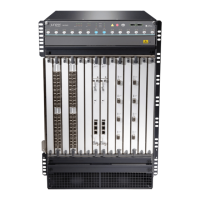2
Features and Benefits
MPLS
An example of technical advancement and ongoing standards
development that is driving the evolution of Ethernet in the service
provider edge can be found in Multi Protocol Label Switching
(MPLS)technology.MPLShastraditionallybeenfoundinnetwork
backbones to provide traffic engineering and allow the carriage
ofawiderangeofLayer2andLayer3trafcsuchasIP,Frame
Relay and ATM. Extending MPLS to the Ethernet edge brings
benefits such as restoration techniques, Operations, Administration
&Management(OA&M)diagnosticcapabilitiesandQoSsupport
for services that are sensitive to delay and delay variation. As an
industry leader in the development and deployment of MPLS,
Juniper Networks leads the way in making it possible for service
providers to bring to market network architectures and services
based on MPLS. The MX960 provides a wide range of MPLS
features and functionality powered by the JUNOS operating system.
The feature richness of JUNOS provides the MX960 an advantage
over other operating systems that are either too immature to
support the required MPLS feature breadth or architected in a
monolithic fashion, making them too complicated or unwieldy to
efficiently manage. Additionally, the MX960 is designed to lead the
industry in the following areas:
• Interface Scalability—asthelargestformfactorintheMX-series,
theMX960chassisprovidesupto12slotsthatcanbepopulated
withupto480portsofGigabitEthernetorupto4810GEports.
• Advanced Packet Processing Performance—eachslotprovides
line-rate40Gbpspacketforwarding.
• Service Flexibility—Juniperisanindustryleaderinboth
MPLS and VPLS, and the new MX960 Ethernet Services Router
leverages the JUNOS operating system that is powering over
27,000JuniperM-seriesrouterscurrentlydeployedinover600
service provider networks worldwide. The field-proven JUNOS
provides the MX960 feature richness, stability, and service
breadthnottypicallyfoundinCarrierEthernetplatforms.
• Advanced QoS—theMX-seriesfeaturessuperiorQoSatthe
interface level, which improves port density, can reduce costs
and enables service providers to ensure that services receive
the appropriate level of service regardless of traffic conditions.
This enables providers to offer a variety of Layer 2 and Layer 3
servicesoverEthernet,suchasVLAN/transparentLAN,L2/L3
VPNs,voiceoverIPandvideooverIP,withguaranteedservice
levelagreements(SLAs).
• Simple, Non-Disruptive Deployment—becausethenew
MX-series utilizes the same JUNOS operating system that the
world’s largest service providers have relied on for years, service
providers can immediately take advantage of the latest Ethernet
technology without the cost and risks associated with introducing
anewoperatingsystemtothenetwork.Customers’familiarity,
knowledge and integration of JUNOS in existing back-office
systems allows them to drive down capital expenditure costs
while rapidly rolling out Ethernet access networks and services.
The MX-series Extends JUNOS in the Network
JUNOS is a world-class operating system with proven stability
coupled with industrial-strength routing protocols, flexible policy
language and leading MPLS implementation. When building your
Ethernet-centric infrastructure, JUNOS can be a tremendous asset
as a flexible and reliable operating system.
JUNOSInternetsoftwarerunsonJuniperNetworksMX-,M-,T-,and
J-seriesrouters.JUNOSsoftware—the first routing operating system
developed specifically for the Internet—isespeciallydesignedforthe
large production networks typically supported by service providers.
JUNOS has been designed to configure the routing protocols that
run on the MX960 and the properties of its interfaces. After a
software configuration is activated, JUNOS has been designed to
monitor the protocol traffic passing through the MX-series and to
troubleshoot protocol and network connectivity problems.
JUNOS software runs on the Routing Engine and consists of
processes that:
•SupportInternetroutingprotocols
•ControltheMX-seriesinterfaces
•ControltheroutingofeachMX-serieschassis
•Provideaninterfaceforsystemmanagement
JUNOS full suite of industrial-strength routing protocols, flexible
policy language, and leading MPLS implementation efficiently
scales to large numbers of network interfaces and routes.
MX960 VPNs
JUNOS supports several types of VPNs:
• Layer 2 VPNs—linkingasetofsitessharingcommonrouting
information, and whose connectivity is controlled by a collection
of policies. A Layer 2 VPN is not aware of routes within a
customer’snetwork.Itsimplyprovidesprivatelinksbetween
a customer’s sites over the service provider’s existing public
Internetbackbone.
•Layer 3 VPNs—linkingasetofsitesthatsharecommonrouting
information, and whose connectivity is controlled by a collection
of policies. A Layer 3 VPN is aware of routes within a customer’s
network, requiring more configurations on the part of the service
provider than a Layer 2 VPN. The sites that make up a Layer
3 VPN are connected over a service provider’s existing public
Internetbackbone.
•Interprovider VPNs—supplyingconnectivitybetweentwoVPNs
inseparateautonomoussystems(ASs),thisfunctionalitycould
beusedbyaVPNcustomerwithconnectionstovariousISPs,
ordifferentconnectionstothesameISPinvariousgeographic
regions.
•Carrier-of-Carrier VPNs—allowingaVPNserviceproviderto
supply VPN service to a customer who is also a service provider.
ThelatterserviceprovidersuppliesInternetorVPNservicetothe
end customer.

